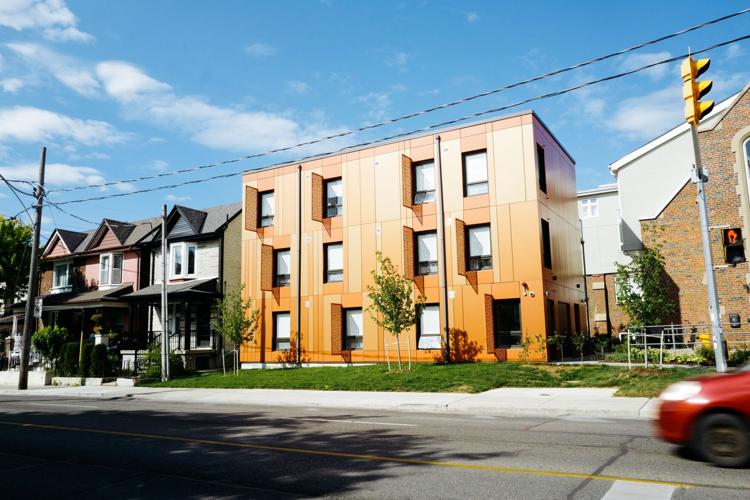Mattamy É«É«À²s’ founder has a lofty goal — in 2026, open a GTA-based factory to pump out 3,000 prefabricated homes a year.
Prefabricated homes, or modular housing, aren’t anything new — some laneway and garden suites in É«É«À² are prefabricated and the city has built hundreds of prefabricated units to house the homeless population. But the idea of scaling up this housing product has been revived with Prime Minister Mark Carney’s pledge to provide $26 billion to builders of prefabricated homes to help reach his national goal of 500,000 new homes per year.
Prefabricated homes are made in a factory and then assembled on-site — and experts say the process can be faster, cheaper and more sustainable than traditional home construction.
The process is a game-changer to speed up construction timelines and deliver much-needed supply, said Peter Hass, general manager of Stelumar Advanced Manufacturing, a technology company started by Peter Gilgan, founder and CEO of Mattamy Asset Management (the parent company of Mattamy É«É«À²s). Stelumar will open the GTA-based factory, with the primary market being Ontario.
“The main benefit is speed and the cost benefit associated with it,” Hass said.Â

A factory photo courtesy HOMAG, the German manufacturer of the automated machinery that will be in Stelumar’s GTA factory
HOMAGWhile prefabricated housing holds “big promise,” we’re not there yet in terms “of really understanding how to work with it and optimize it,” said Naama Blonder, an architect and urban designer who co-founded É«É«À²-based design firm Smart Density.
“It should be cheaper, more predictable, more accurate and save time,” but Canada needs more factories, infrastructure, technology, engineering and design to scale up building prefabricated housing, which will take time, she added.Â
Here’s what it would take to get there.Â
To lower costs, time is of the essenceÂ
Developing on land in Canada is expensive — and the longer a builder has to hold on to the land, the more expensive the project becomes, experts say.Â
‘It’s like turning the Titanic around,’ say industry players of ramping up home production.
With prefabricated construction, Emilia Floro, director of city planning, urban design, with the City of É«É«À², said there is the potential for the overall price per square foot to be 30 per cent less.Â
For example, a highrise takes three to five years with traditional construction. If that timeline can be cut down drastically, so too will carrying costs such as property tax, insurance, and loan debt servicing, which will translate to lower costs for the unit itself, she said.Â
Hass agrees.
“If you can cut off a whole bunch of time used to hold on to that land, that saves the developer money in the short to medium term,” Hass said.Â
Long-term, the more developers build prefabricated homes, the more competitive pricing becomes, he said.Â
Building more missing middleÂ
There’s two types of prefabricated homes.
There’s 3D volume, meaning the entire unit is constructed off-site and then assembled on-site like Lego.
Then there’s panelized prefabricated, in which premade two-dimensional panels are put together on-site to make the three-dimensional unit.

The exterior of a prefabricated midrise building on Ossington Avenue in É«É«À². Experts say the city’s zoning restrictions are a barrier to scaling up the prefabricated method.
Michelle Mengsu Chang É«É«À² StHass said volumetric prefabricated construction (3D volume) will be used for multi-unit housing that integrates into single-family home neighbourhoods — known as missing middle — such as six-storey, 47-unit buildings containing two- or three-bedroom apartments. The work could be done in six to 10 months.Â
“From a consumer standpoint, when a (traditional preconstruction) buyer purchases years before the completion date their circumstances can change,” he said.
´¡»å»å¾±³Ù¾±´Ç²Ô²¹±ô±ô²â,Ìýhundreds of preconstruction buyers are now unable to close on their units as interest rates have increased rapidly since they bought a few years back and property values have dropped simultaneously.Â
“This allows buyers to buy what’s right for them at the time,” Hass said, adding it could be a more attractive option for end users compared to traditional preconstruction condos or houses.
Exclusive data from HouseSigma shows a huge spike from the pandemic peak, with sellers out
There’s also less of an impact on the community when construction takes less time, Hass said, significantly reducing road blocks and noise.
This type of development is primed for the É«É«À² Major Streets bylaw, said Floro, which aims to encourage townhouses and apartment buildings up to six storeys along select major streets.
“Developing along major streets could help facilitate this type of building and it has the potential to really take off,” Floro said.Â
Zoning restrictions a barrierÂ
While there is cost-saving potential with prefabricated housing, there are barriers to scaling up production and working within É«É«À²’s building approval timelines and zoning bylaws.Â
On June 25, city council decided to water down a proposal to legalize sixplex housing citywide — legalizing them only in old É«É«À² and East York, plus one ward in Scarborough.

A handout photo of modular building courtesy HOMAG, the German manufacturer of the automated machinery that will be in Stelumar’s GTA factory.Â
HOMAGThe restrictive zoning in É«É«À² and limitations with Ontario’s building code hurt the potential for prefabricated housing to be scaled up in the city, said Carolyn Whitzman, adjunct professor and senior housing researcher at University of É«É«À²â€™s School of Cities.
“The only way that prefabricated homes can be cheaper on-site is if it is scaled up to the point where preapproved designs are sailing through the approval process,” she said.Â
“At the moment it’s impossible to scale this up in É«É«À².”Â
Ensuring demand to scale up
“A big game-changer would be federal government guaranteeing demand for the next five years,” Whitzman said, adding there have been bankruptcies with prefabricated factories because demand hasn’t remained steady.Â
The government could accomplish this with nonmarket housing such as student housing and supportive housing, she said, which the country will always need.
“These are two ways to roll out prefabricated housing quickly and help build up the industry with a sustainable pipeline,” she said.Â
While there isn’t a target for how many prefabricated homes to build, Floro said the city is working diligently to meet the province’s goal of 285,000 residential units by 2031, representing a 23 per cent increase in É«É«À²’s housing supply within 10 years.Â
Meeting this target would mean the completion of 31,050 homes per year.
While the city exceeded 2023’s target for housing starts, it reached 85 per cent of 2024’s target and, in the first quarter of this year, reached 10 per cent of the 2025 target.


































To join the conversation set a first and last name in your user profile.
Sign in or register for free to join the Conversation